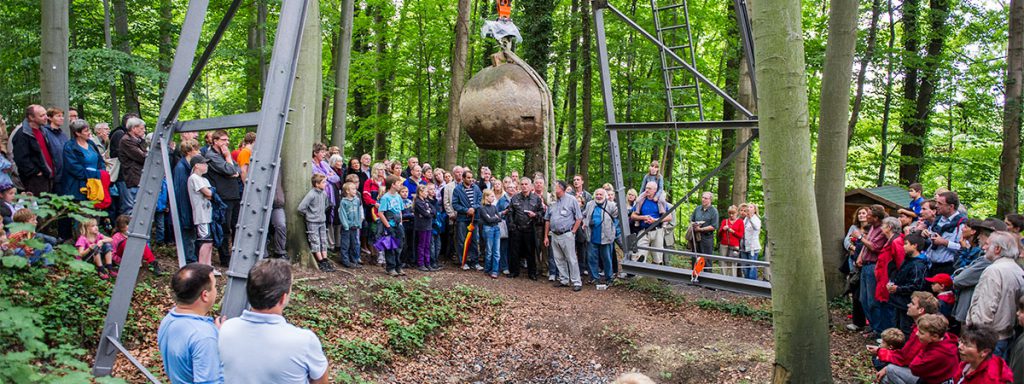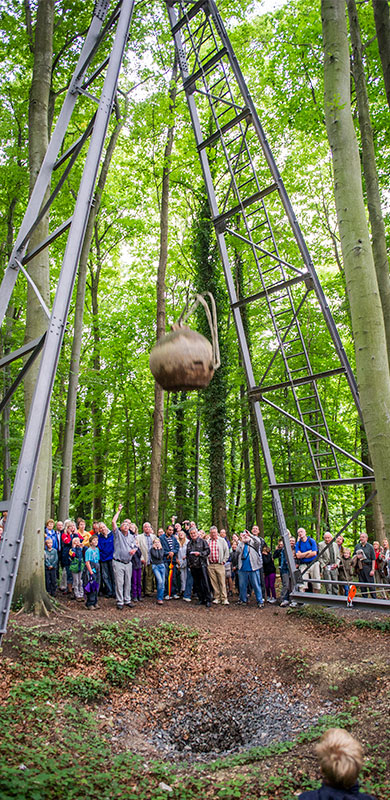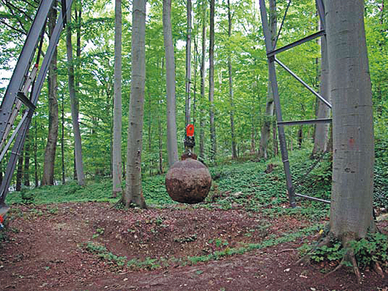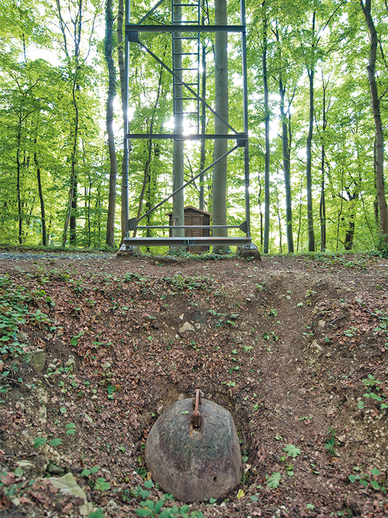
Drop tower Mintrop ball
Artificial “earthquakes” are triggered by the drop tower of the Mintrop ball – monthly falls the 4-ton Mintrop ball made of steel in the shell limestone soil of Göttingen Hainberg – highlight of the regular tours
Historical Earthquake Station | Buildings & Site
Drop tower for the Mintrop ball
In 1908, Ludger Mintrop, a student of Wiechert’s (see Persons), started to generate artificial earthquakes and record the ground waves at various distances using portable seismographs with a magnification of up to 50,000. He had a 14-m high steel scaffolding built and used it to drop a four-tonne steel ball, donated by the company Krupp.
Drop tower Mintrop ball
On the first Sunday of each month, we repeat the drop of the Mintrop ball as part of a guided tour. For more information, go to the website section about the Mintrop ball.
Ludger Mintrop was an able student of Wiechert’s and one of the founders of modern geophysics. In 1908, he was the first to artificially produce sizeable earthquakes – an idea that would later make him a fortune. He had a steel scaffolding built at the Earthquake Station and used it to drop a four-tonne steel ball – donated by the company Krupp – onto the bedrock of shell limestone. Portable seismographs were used to record the resulting artificial seismic ground waves at various distances with a magnification of up to 50,000. This made it possible to accurately identify distinctive boundaries in deep rock layers. This method was originally intended for use in mining, but, with the rise of the oil industry, gained special significance in this field.
Crude oil wells detected
These experiments soon gave rise to the seismic exploration method. Mintrop replaced the heavy ball with dynamite later on. The prospecting company Seismos GmbH was founded in 1921, with Mintrop taking a major stake in the business. With his method, Mintrop succeeded in creating a “3D picture” under the Earth’s surface, identifying distinctive boundaries in rock and locating specific layers of solid or liquid matter – for example crude oil and other mineral resources. The pioneer of geophysics used his patented seismic measurement technique to search for deposits all over the world, in particular oil – a course of action that not only brought him recognition, but also great business success.
On 7 December 1919, mine surveyor and geophysicist Ludger Mintrop took out a patent for his method of exploring the structure of rock layers. The establishment of Seismos GmbH by Mintrop as well as the coal and steel groups Deutsch Lux, Phoenix, Hoesch, Thyssen and Rheinstahl then followed on 4 April 1921. The purpose of the company was to explore rock layers and locate usable mineral reserves.
Initial work in Germany, Austria, Poland, Holland and Sweden was dedicated to detecting and marking out coal deposits as well as ore bodies and quartzite deposits. To obtain readable signals, artificial earthquakes had to be produced using tremendous amounts of explosives. Mintrop developed an entirely new method, which would later become known as refraction seismology. This method allowed him to explore the salt domes in the crude oil regions of Lower Saxony and find crude oil using this indirect route.
This is what Wikipedia says about Seismos
Breakthrough and crisis of Seismos
The breakthrough came in 1923: AGUILA, a subsidiary of SHELL, brought a surveyor team to Mexico to break fresh ground in the Golden Lane oil fields. In the same year, Seismos was deployed in the U.S. on behalf of the company MARLAND Oil Co., today operating under the name CONOCO, followed by further deployments for GULF OIL and soon also for ROXANA, a subsidiary of SHELL. On 19 November 1924, the first oil deposit was detected for GULF OIL in Texas, near Houston, by a surveyor team of Seismos. After drilling into the salt dome flanks, a rich oil field was detected.
The discovery attracted a great deal of media attention, which quickly made the exploration method well known. Rumours of a German patent and scientists coming from Germany and working miracles were doing the rounds. Seismos surveyor teams were subsequently also deployed in Egypt, Iraq and Iran.
Fully motorised Seismos surveyor team in Louisiana in 1926
The monopoly of Seismos began to crumble after about five years, because Mintrop’s method and instruments were copied despite the patent. By the beginning of the Great Depression, the activities of Seismos in the U.S. came to an end. Germany and Europe did not place any new orders either. Also before, the revenue within






